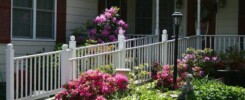Blog Brought to you by Senior Advice
By April Klazema, Guest Author / Blogger
While residential senior care facilities have their place, many seniors would prefer to live in their homes for as long as possible. This can make sense from an emotional as well as an economic perspective, especially if a home is already paid for and the family of the senior is looking to avoid the expense associated with a retirement community.
However, there are special considerations that must be taken in order to ensure that homes are safe for seniors. Things that might once have proved a minor nuisance can become dangerous to seniors. Consider looking into these details to help ensure that a home is safe for your loved one so that they can continue to live comfortably and independently for as long as possible.
Getting Started

Before you begin making improvements to the home, look at the condition of the home environment and whether it could prove hazardous to a senior. Clutter of any kind can be dangerous, so take the time to clear out clutter and to put unnecessary items into storage, if possible.
It can also be a good idea to evaluate the arrangement of furniture within the home. Ensure that seniors have a clear path to get where they need to go, and consider removing items of furniture as necessary to make this possible.
Remember to perform a thorough investigation of the home to identify potential problem areas. Because seniors may not be able to climb or lift themselves to reach things that they need, simply moving items off of high shelves and into more accessible locations can be very beneficial.
Flooring
As you set out to make a home safe for your loved one, it’s a good idea to start from the ground up. A great number of injuries to seniors occur as the result of slips, trips, and falls, so ensuring that the flooring is as safe for them as possible can be an important first step.
Start by examining the flooring to determine if there are any areas, such as minor steps, that may pose a hazard to a senior. While it may seem minor to you, remember that a senior’s mobility may be limited. If safety seems to be a concern, you may consider the installation of a ramp to make areas of the home easier to access and to prevent the possibility of falls.
It can also be a good idea to evaluate the type of flooring within the home to determine whether it should be replaced. Area rugs can be a major source for trips and falls. Consider using materials to secure area rugs to the floor to ensure that the edges remain secure and don’t present a tripping hazard. (In some instances, it may be best to remove area rugs completely.) Non-slip strips and mats can be used on steps and in areas of the home such as the kitchen and bathroom to reduce the possibility of falls on slippery flooring. Non-skid floor wax is also available to make it easier and safer for seniors to walk on certain types of flooring.
Bathrooms
Bathrooms are one of the more common areas for accidents in the home, so it is well worth the investment to make the bathroom as secure as possible. As with other areas of the home, begin by ensuring that there is no clutter, and that it is easy for seniors to move throughout the bathroom as needed. Also pay attention to the flooring, and make sure that you have taken the steps needed to ensure that it is safe to walk on, even when wet. Having adequate non-slip bath mats can help with this.
Include non-slip mats inside the bathtub or shower as well, and consider whether or not your senior can stand inside the shower. There are many tools available to help make the shower safer. Consider the installation of a bar for them to grip onto, if necessary, or else look for items such as shower seats to prevent falls inside the shower. Handheld shower sprays can also be of great help, especially when used in combination with shower seats.
Other useful bathroom items include toilet seats, which add height to the toilet so that seniors don’t have to lower and lift themselves as much in order to use the toilet, as well as safety frames that give them something to hold onto when lowering or lifting themselves.
Outdoor Safety
Remember that it is as important to secure the outside area of a home as it is to secure the inside area. Pay attention to decks and patios, especially those made of wood. A good power washing can be surprisingly important to removing potential splinters that could harm an elderly loved one, especially if they don’t notice it right away (as can happen with certain circulatory problems).
Make it easy for them to enjoy certain tasks such as gardening by making outdoor areas easily accessible. Simply installing sprayers to garden hoses can be of benefit, as it prevents the need to bend down and turn on hoses at the source.
And finally, be sure to take the time to go along the entire yard to look out for problems such as holes, roots, and other areas that could potentially lead a senior to trip and fall. These seemingly simple steps can make all the difference in ensuring the safety of your loved one.
Working With a Senior to Ensure Their Safety
One of the most important things that you can do is have a conversation with your senior loved one regarding their safety. While they may feel embarrassed about the need to safe-proof their home, remind them that doing so will keep them independent for longer. Additionally, be sure that you’re checking in with them, and that you have a plan in place for hiring an in-home caregiver or else moving them into a senior facility if necessary to ensure their wellbeing. While independence is a great thing, it should never come at the cost of your loved one’s safety.


